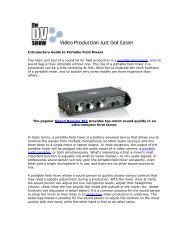Create successful ePaper yourself
Turn your PDF publications into a flip-book with our unique Google optimized e-Paper software.
0308ccu10 <strong>Depth</strong> <strong>of</strong> field 22/5/03 3:18 pm Page 22<br />
FIELD OF<br />
DREAMS<br />
Jim Tyler explains the age-old<br />
conundrum <strong>of</strong> <strong>Depth</strong> <strong>of</strong> <strong>Field</strong>.<br />
Learn to use it and add a<br />
pr<strong>of</strong>essional touch to your videos<br />
Everybody thinks they know<br />
roughly what <strong>Depth</strong> <strong>of</strong> <strong>Field</strong><br />
(DoF) is, but only a few people<br />
really understand what its implications<br />
are – and believe me, there are<br />
plenty <strong>of</strong> common misconceptions on<br />
the subject.<br />
A lens is only precisely focused at one<br />
point, and the further away from that<br />
single point a subject is, the less sharp<br />
its focus. <strong>Depth</strong> <strong>of</strong> <strong>Field</strong> is the distance<br />
between the closest and most distant<br />
points from the lens at which the subject<br />
is in reasonably sharp focus.<br />
This means that when you shoot a<br />
panorama with a person standing in<br />
the near foreground, either the person<br />
or the background can be in focus –<br />
but not both. <strong>Depth</strong> <strong>of</strong> <strong>Field</strong> can be<br />
increased by using a smaller aperture<br />
or by moving further away from the<br />
subject, provided the focal length is<br />
constant – that is, you don’t zoom in.<br />
I’ve just read an article about <strong>Depth</strong> <strong>of</strong><br />
<strong>Field</strong> on a camcorder internet site, and it<br />
included the fact that DoF decreases<br />
with lens to subject distance (which is<br />
correct) but suggested that, in order to<br />
get the same image with greater DoF,<br />
you simply moved further away from<br />
the subject and zoomed in to achieve<br />
the same frame – which is balderdash!<br />
If you shoot a subject that’s just a<br />
yard away then the DoF will be very<br />
small, maybe between 2ft 9in and 3ft<br />
9in, depending on the aperture. Move<br />
back another twenty yards and shoot at<br />
20x magnification, so that the subject<br />
occupies the same amount <strong>of</strong> screen,<br />
and the DoF will be exactly the same –<br />
3in either side <strong>of</strong> the point at which<br />
the lens is focused to give a total DoF<br />
<strong>of</strong> 6in. What will change as a result <strong>of</strong><br />
moving further away and zooming in<br />
is the perspective, making your subject<br />
matter appear ‘flatter’.<br />
<strong>The</strong>re is, in fact, only one way <strong>of</strong><br />
altering the DoF for a given subject<br />
occupying a given area <strong>of</strong> the screen,<br />
and that is to vary the lens aperture.<br />
<strong>The</strong> smaller the aperture, the greater the<br />
depth <strong>of</strong> field. If you vary the aperture<br />
the time that the CCD is exposed must<br />
also vary, so that the correct amount<br />
<strong>of</strong> light reaches it. To get the correct<br />
exposure with a smaller aperture it’s<br />
necessary to lengthen the exposure,<br />
and vice-versa. Unfortunately, unlike<br />
stills photographers, who record only<br />
an instant in time and not time itself,<br />
we are stuck with 1/25th <strong>of</strong> a second<br />
exposure and can’t vary exposure time<br />
without suffering side effects.<br />
To decrease depth <strong>of</strong> field, which we<br />
do in order to throw undesired elements<br />
<strong>of</strong> a scene completely out <strong>of</strong> focus, we
0308ccu10 <strong>Depth</strong> <strong>of</strong> field 22/5/03 3:19 pm Page 23<br />
<strong>Depth</strong> <strong>of</strong> <strong>Field</strong> <strong>The</strong> Knowledge<br />
need a wider aperture. This involves<br />
reducing the exposure time in order to<br />
keep the same amount <strong>of</strong> light being<br />
processed by the CCD. <strong>The</strong> problem<br />
with reducing the exposure time is that<br />
we record only segments <strong>of</strong> time and,<br />
if the exposure is very short, this gives<br />
jerky onscreen movement.<br />
Decreasing the exposure time to<br />
1/50th <strong>of</strong> a second won’t make your<br />
video look like cine film, but the effect<br />
on DoF won’t be much to write home<br />
about either – just one stop. At 1/100th<br />
<strong>of</strong> a second the effect on motion begins<br />
to be apparent, and still you will have<br />
opened the iris only a couple <strong>of</strong> stops.<br />
Whether such small changes in aperture<br />
will be sufficient depends on what<br />
you’re shooting and, perhaps more<br />
specifically, how far away from the<br />
lens the point <strong>of</strong> focus is.<br />
Increasing the exposure time beyond<br />
1/25th <strong>of</strong> a second to achieve a smaller<br />
aperture and so extend the depth <strong>of</strong><br />
field (not all camcorders allow this)<br />
obviously means shooting at less than<br />
25 frames per second, meaning that<br />
onscreen movement is really jerky.<br />
<strong>The</strong>re is a better way!<br />
Lighting-up time!<br />
If you shoot a very bright scene the<br />
auto exposure will give you all the DoF<br />
your heart could desire by selecting a<br />
small aperture for you, and vice versa.<br />
If you shoot using artificial lighting you<br />
can vary its intensity at will, but most<br />
video is shot using natural daylight, over<br />
which we have no control other than to<br />
try to select the right day, and time <strong>of</strong><br />
day, to shoot!<br />
Put simply, if you want, for instance,<br />
to shoot a panorama and get as much<br />
as possible <strong>of</strong> it in passably sharp focus,<br />
do it on a day with a cloudless sky,<br />
sometime between mid-morning and<br />
mid-afternoon. If you want to get just<br />
one specific element <strong>of</strong> the scene in<br />
focus and lose the rest then shoot on<br />
a dull day.<br />
Most <strong>of</strong> the time, we want to get as<br />
much <strong>of</strong> the scene as we can in focus,<br />
Far Left: <strong>The</strong> rose is<br />
about a yard from the<br />
camcorder, which is at<br />
a wide-angle setting.<br />
Note that both the<br />
near and distant<br />
foliage is out <strong>of</strong> focus<br />
– in fact, some is<br />
barely recognisable<br />
Left: Taken from three<br />
yards away at three<br />
times the magnification<br />
(so that the rose<br />
appears roughly the<br />
same size). <strong>The</strong> <strong>Depth</strong><br />
<strong>of</strong> <strong>Field</strong> is the same.<br />
Moving back from a<br />
subject and zooming<br />
in does not alter DoF –<br />
to do that you need to<br />
close down the iris!<br />
What has been altered<br />
is the perspective –<br />
the shot is from a<br />
different position<br />
Below: Here’s the<br />
same shot, taken with<br />
the iris stopped down.<br />
Compare this with the<br />
previous shot and<br />
you’ll see both nearer<br />
and more distant<br />
detail in better focus<br />
‘<strong>The</strong>re is, in fact, only<br />
one way <strong>of</strong> altering<br />
the DoF for a given<br />
subject occupying<br />
a given area <strong>of</strong> the<br />
screen, and that<br />
is to vary the<br />
lens aperture’<br />
23<br />
Camcorder User & <strong>DV</strong>D Movie Maker August 2003
0308ccu10 <strong>Depth</strong> <strong>of</strong> field 22/5/03 3:19 pm Page 24<br />
<strong>The</strong> Knowledge<br />
<strong>Depth</strong> <strong>of</strong> <strong>Field</strong><br />
‘Sadly, not one<br />
current consumer<br />
camcorder that<br />
<strong>of</strong>fers manual focus<br />
has a distance scale<br />
engraved on the<br />
lens barrel’<br />
and you don’t necessarily have to be at<br />
the very smallest aperture to achieve<br />
enough DoF. A mid-range aperture <strong>of</strong><br />
ƒ8 to ƒ11 will give reasonable DoF<br />
and, perhaps more importantly, the<br />
resolving power <strong>of</strong> a lens peaks at<br />
these apertures.<br />
If you want to get the far distance<br />
in focus, different apertures effectively<br />
give different closest points <strong>of</strong> focus. At<br />
ƒ22 you might get everything from the<br />
horizon down to 6ft in front <strong>of</strong> the lens<br />
in focus when shooting without any<br />
zoom, at ƒ16 the point <strong>of</strong> close focus<br />
might extend to 8ft, at ƒ11 it might be<br />
11ft, at ƒ8 15ft and at ƒ4 nearer 30ft.<br />
Unfortunately you’ll find that <strong>Depth</strong><br />
<strong>of</strong> <strong>Field</strong> figures are not exact. This is<br />
because there is no hard and fast<br />
definition <strong>of</strong> what constitutes reasonable<br />
focus – it is subjective and will vary<br />
according the circumstance. It could be<br />
so sharp that you can see individual<br />
hairs on a subject’s head, or just sharp<br />
enough to recognise that the subject<br />
was a person! Another inexact figure is<br />
the Hyperfocal distance. This is the<br />
distance at which the lens should focus,<br />
in order for both a desired distant point<br />
<strong>of</strong> focus, and a desired close point <strong>of</strong><br />
focus (which is half the Hyperfocal<br />
distance), to be tolerably sharp.<br />
Focus <strong>of</strong>f the subject<br />
It might sound daft, but there are times<br />
when it can pay not to focus directly<br />
on the main subject. <strong>The</strong> Hyperfocal<br />
distance might be theoretical but the<br />
principle can be used in practice to<br />
achieve the shots you really want.<br />
Suppose that your main subject is<br />
20ft away and that you want both the<br />
subject and some more distant parts <strong>of</strong><br />
the scene to be in focus. If you allow<br />
the auto focus to settle on the main<br />
Left: In order to get mini <strong>DV</strong> picture<br />
quality with none <strong>of</strong> the colour bleed<br />
<strong>of</strong> analogue tape, and also keep control<br />
over focus and <strong>Depth</strong> <strong>of</strong> <strong>Field</strong>, Jim has<br />
taken the extraordinary step <strong>of</strong> coupling<br />
his JVC GR-S707 and Sony TRV20<br />
subject, the DoF might not extend far<br />
enough behind it to accommodate<br />
the background. However, if you force<br />
focus on 30ft, both the subject and the<br />
background should be in focus, given<br />
that the aperture is sufficiently small<br />
to grant that DoF.<br />
Sadly, not one current consumer cam<br />
that <strong>of</strong>fers manual focus has a distance<br />
scale engraved on the lens barrel. This<br />
has become a no-go feature for camcorder<br />
manufacturers in recent years,<br />
and while my old S-VHS model does<br />
feature it, you’ll look long and hard<br />
before you see it on any <strong>of</strong> today’s<br />
models. While manufacturers might not<br />
include a calibrated lens ring many <strong>of</strong> the<br />
higher end enthusiast models do at least<br />
give focusing and exposure details on the<br />
LCD screen and optical viewfinder.<br />
<strong>The</strong> GR-S707 also allows me to set<br />
aperture in terms <strong>of</strong> f-stops and so gives<br />
complete control over not only focus but<br />
also DoF. <strong>The</strong> majority <strong>of</strong> manual focus<br />
rings are now ‘fly by wire’ jobs that are<br />
pretty well useless, meaning that – even<br />
with camcorders that <strong>of</strong>fer manual focus<br />
– it is <strong>of</strong>ten better to manipulate the<br />
auto focus than to try to focus manually.<br />
So how do you ‘manipulate’ auto<br />
focus? Simply give it a ‘target’ at the<br />
desired distance. This means placing<br />
the main subject <strong>of</strong>f-centre and having<br />
something at the correct distance occupying<br />
centre screen. If your camcorder<br />
<strong>of</strong>fers focus lock, engage it and re-frame<br />
or, if your camcorder has manual focus,<br />
engage that and re-frame.<br />
24<br />
Camcorder User & <strong>DV</strong>D Movie Maker August 2003<br />
Close encounters<br />
<strong>The</strong>re is another way in which you can<br />
get a subject in sharp focus and get<br />
the background hopelessly out <strong>of</strong> focus<br />
– and that is to get very close to the<br />
subject. This is because <strong>Depth</strong> <strong>of</strong> <strong>Field</strong><br />
is reduced as the point <strong>of</strong> focus gets<br />
closer to the lens. Unfortunately, in order<br />
to get really close you need to go wide<br />
angle, so that the DoF increases! ■





